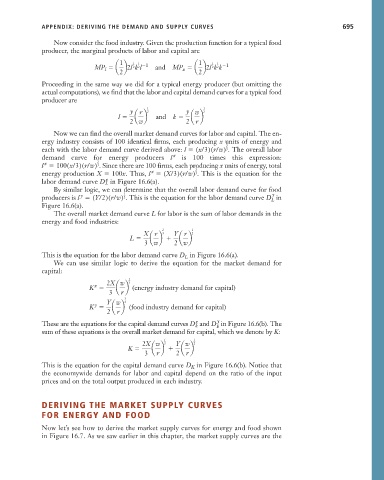Page 721 - Microeconomics, Fourth Edition
P. 721
c16GeneralEquilibriumTheory.qxd 8/16/10 9:14 PM Page 695
APPENDIX: DERIVING THE DEMAND AND SUPPLY CURVES 695
Now consider the food industry. Given the production function for a typical food
producer, the marginal products of labor and capital are
1 1 1 1 1 1
2 1
2 1
MP a b2l k l and MP a b2l k k
2
2
x
l
2 2
Proceeding in the same way we did for a typical energy producer (but omitting the
actual computations), we find that the labor and capital demand curves for a typical food
producer are
1 1
y r 2 y w 2
l a b and k a b
2 w 2 r
Now we can find the overall market demand curves for labor and capital. The en-
ergy industry consists of 100 identical firms, each producing x units of energy and
2
each with the labor demand curve derived above: l (x/3)(r/w) . The overall labor
3
demand curve for energy producers l x is 100 times this expression:
x
l 100(x/3)(r/w) 2 3 . Since there are 100 firms, each producing x units of energy, total
x
energy production X 100x. Thus, l (X/3)(r/w) 2 3 . This is the equation for the
labor demand curve D x L in Figure 16.6(a).
By similar logic, we can determine that the overall labor demand curve for food
y
producers is l (Y/2)(r/w) 1 2 . This is the equation for the labor demand curve D L y in
Figure 16.6(a).
The overall market demand curve L for labor is the sum of labor demands in the
energy and food industries:
2 1
X r 3 Y r 2
L a b a b
3 w 2 w
This is the equation for the labor demand curve D in Figure 16.6(a).
L
We can use similar logic to derive the equation for the market demand for
capital:
1
2X w 3
x
K a b (energy industry demand for capital)
3 r
3
Y w 2
y
K a b (food industry demand for capital)
2 r
These are the equations for the capital demand curves D x k and D k y in Figure 16.6(b). The
sum of these equations is the overall market demand for capital, which we denote by K:
1 1
2X w 3 Y w 2
K a b a b
3 r 2 r
This is the equation for the capital demand curve D in Figure 16.6(b). Notice that
K
the economywide demands for labor and capital depend on the ratio of the input
prices and on the total output produced in each industry.
DERIVING THE MARKET SUPPLY CURVES
FOR ENERGY AND FOOD
Now let’s see how to derive the market supply curves for energy and food shown
in Figure 16.7. As we saw earlier in this chapter, the market supply curves are the

